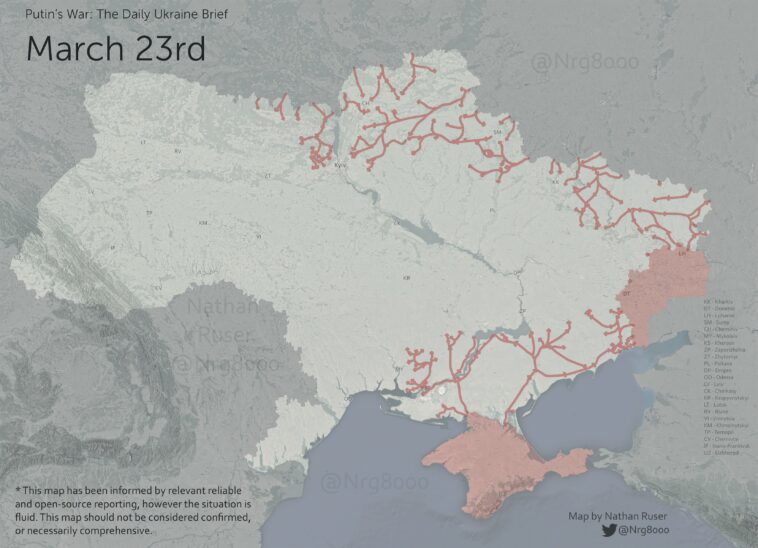Russia drops white phosphorus munitions on outskirts of Kyiv. Late in the evening of March 22, the Russian troops used white phosphorus munitions on the northern-western outskirts of Kyiv. The tentative impact area comprises Hostomel and Irpin, said Irpin mayor Oleksandr Markushyn.
The first use of phosphorus munitions occurred during World War I. Between 1970s and 1980s, they were banned by international conventions including by protocols to the Geneva Conventions of 1977 due to their indiscriminate effect and severe suffering they inflict.
White phosphorus burns at more than 800 degrees Celsius. Fire can spread to hundreds of square meters. White phosphorus causes severe burns, while clothes remain intact. Inhalation exposure to white phosphorus damages lungs. White phosphorus absorbs into the body through skin contact damaging internal organs. The only way to minimize the impact is to cut oxygen off the damaged tissues. The only reliable way to self-protect is to shelter to avoid contact with white phosphorus.
Earlier Russia used white phosphorus munitions during active fighting in Donbas.
Russia’s losses: up to 40,000 troops, more than 100 aircraft. NATO estimates that between 7,000 and 15,000 Russian soldiers have been killed since the invasion began on February 24. Up to 40,000 Russian troops have been killed, wounded, taken prisoner or are missing in Ukraine.
The Ukrainian Armed Forces destroyed 105 Russian aircraft since the invasion began, advisor to the Office of the President of Ukraine Oleksiy Arestovych said.
Russians’ support of war on the rise, survey. Russians increasingly back the war against Ukraine as dissent declines, a survey by the Russian Public Opinion Research Center (VCIOM) finds. About 74 per cent of respondents said they somewhat supported the action, a nine per cent increase from February 25.
About 17 per cent do not support the operation, an eight per cent decrease from February 25. Nine per cent said they were on the fence.
The Russians’ views of the “special operation’s” goals did not change in the past two weeks. Forty-six per cent say Russia wages a war in Ukraine to protect itself, disarm Ukraine, and thwart NATO from installing bases in the country.
Explaining Ukraine podcast. Tragedies of Mariupol and Chernihiv; Ukraine’s counterattack near Kyiv
Human stories from Mariupol; Ukrainians counterattack near Kyiv; Russians lost more soldiers than Soviet Union during 10 years in Afghanistan. We continue our “Explaining Ukraine” podcast by discussing horrible consequences of Russian invasion of Ukraine. Hosts: Volodymyr Yermolenko, analytics director at Internews Ukraine, and Tetyana Ogarkova, in charge of international outreach at the Ukraine Crisis Media Centre. Listen to the podcast episode.
Ukraine in Flames #13. Russian energy ban is a health treatment to the global economy
UKRAINE IN FLAMES project is created by Ukraine Crisis Media Center, Ukrainian Catholic University’s analytical center and NGO “Euroatlantic Course”. We are aiming at searching a loud support for Ukraine in the war started by Russia on the 24th of February 2022.
Whatever happens with oil and gas prices will spike rates of inflation and stress supply chains in every other market across the world. Regardless of obvious shock waves that the Russian energy ban sent across the global economy, sanctioning the Russian energy sector should continue to deprive the aggressor of resources to continue its assault on Ukraine and develop its military capacity. The adjustment period for Russia’s energy partners in Europe will be short and uncomfortable, but disruptions will be temporary.
The US has already banned all imports of Russian oil, liquefied natural gas, and coal. The EU and the US have announced a ban on new investments across the Russian energy sector. The EU investment ban will apply to the whole energy sector, excluding nuclear energy because some nations in the EU depend on technology from Moscow. The EU will cut two thirds of its gas imports from Russia by the end of 2022 and plans to become independent from all Russian fossil fuels well before 2030. The support for the energy embargo is not unanimous across the Union: some nations were asking for 2030, others 2027, and some now.
Not all European state partners are ready to take a principled stand to stop supply from Russia immediately, as the US did. The largest importers of Russian fossils – Italy, Netherlands, Serbia, Belarus and Germany are not ready to take action. Though the EU and the US have already made significant efforts to end its reliance on Russian oil, gas and coal, Russia still has important energy partners like China and South Korea that are more pragmatic in their choices.
Questions:
How does the Russian energy ban affect its major importers in the short term? What is the prognosis for energy sustainability in Europe, the US and Asia?
What effective alternative energy scenarios are there for the EU, the US and Asia without Russian fossils?
Should the EU put more pressure on its member states to review their energy trade with Russia? Should the US impose pressure on the states that continue energy trade with Russia?
What role can Ukraine play as an energy partner in the European Energy Union?
Speakers:
Olena Pavlenko, President of Dixi Group
Olha Boiko, NGO Ecoaction, coordinator of CAN Eastern Europe, Caucasus and Central Asia
Sviatoslav Pavliuk, Executive Director of Association Energy Efficient Cities of Ukraine
If you want to support Ukraine against Russian aggression, check the link with recommendations by Ukraine Crisis Media Center – https://uacrisis.org/en/help-ukraine
NGO Euroatlantic Course collects donations to support Ukrainian Army and civilians – https://eac.org.ua/en/main-page/




